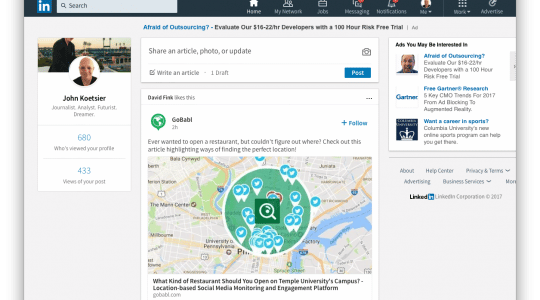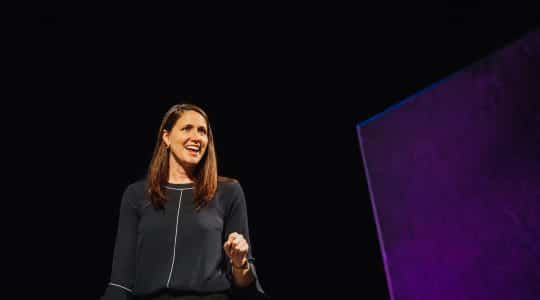
Has this ever sounded like your Friday night? You coordinate what time friends are available in a messaging app. You pop into OpenTable to see which restaurants have reservations available. Jump back into your messaging app to get consensus from everyone. Then double-check how much time you need to get ready by looking up driving distance in Google Maps. Then an hour or two later, order a Lyft.
What if you could streamline that entire experience into one conversation?
… What if your customers could?
That’s exactly the promise of chatbots. Instead of hopping among dozens of apps to accomplish a single goal, chatbots offer marketers and consumers a way to fast-track the process. For consumers, they simplify. Instead of the series of disjointed tasks above, you could simply ask a chatbot to let you know which restaurants are available near you at 7 p.m. and order a Lyft to pick you up. For marketers, they offer ways to increase customer engagement and cut advertising costs.
In this blog post, we’ll show you how marketers can integrate chatbots into their strategies and take a look at a few winning examples.
What Are Chatbots? (And Where Did They Come From?)
Before we dive into the good stuff, let’s ensure we’re all on the same page about what chatbots are. Chatbots are essentially computer programs designed to stimulate conversation with human users.
Despite their recent buzz, chatbots are nothing new. In fact, the first chatbot was created in the 1960s by two computer scientists who envisioned computers communicating like humans do. However, chatbots have only recently taken off with improvements in AI and advancements in personal assistant products like Google’s Alexa and Apple’s Siri.
As UI/UX designer Pete Rojwongsuriya recently explained to Forbes,
“Bots have been around for ages but the reason why it is trending now is that the advancement of AI seen on products such as Google Assistant and Siri that have gone beyond a fad to become a useful product with real impact on the mass.”
How Marketers Can Use Chatbots
1. Help customers get things done.
Utility bots are designed to solve a consumer’s problem via a user-prompted transaction. Utility bots could help your customers order takeout, purchase a new pair of shoes, or book a trip. According to Hubspot research, 47% of shoppers are open to buying items from a bot, and 71% of people are willing to use messaging apps to get customer assistance.
Emirates Vacations, for example, created a chatbot to recommend travel packages to users who asked questions about where they should go on vacation. Emirates Vacations ran ads for the chatbot and compared results to its traditional click-through ads. In just 30 days, the chatbot ads showed an 87% lift in engagement compared to the click-through ads.

Source: Digiday (https://digiday.com/marketing/emirates-brings-chatbot-banner-ads/)
2. Help customers find information.
A chatbot doesn’t have to be purely task-oriented. You could also create an informational bot that provides your customers with information, articles, or data they want.
For example, The New York Times created a chatbot called Sam Manchester for the Rio Olympics. Sam acted as a deputy sports editor, messaging users who signed up with his personal observations from the games. And not just information that anyone could get from headlines, but anecdotes that made users feel like they were behind the scenes at the games, like reading about what athletes were eating before competition.

Source: NiemanLab / The New York Times (http://www.niemanlab.org/2017/04/this-is-how-the-new-york-times-is-using-bots-to-create-more-one-to-one-experiences-with-readers/)
3. Show off your brand’s personality.
If your brand could talk, would it be serious and straight-laced, or have a cheeky accent with a penchant for cat jokes? A chatbot can be purely utilitarian, or it can be an extension of your brand’s personality.
For example, the Outnet’s Facebook Messenger bot starts off predictably, asking users whether they’re looking for wardrobe ideas or customer service help. But the further customers get into conversation with the chatbot, the more personality it shows. Customers could be asked anything, from “Is your style more laid-back L.A. or East Coast elegance?” to “Would you ever leave the house without underwear?”
Designing a Chatbot for Your Customers
Ultimately, customers want the fastest route between their problem and a solution. Chatbots can alleviate customer friction points by automating simple tasks, reducing customer service delays, and quickly answering questions.
To design a chatbot for your customers:
- Map out points in the customer journey that cause the most friction or bottlenecks
- Consider how a chatbot could make the process faster, better, or easier
- Make a list of if-then statements and responses for your chatbot
- Consider which messaging apps your customers use most
Most chatbots integrate with Facebook Messenger, WhatsApp, WeChat, Viber, or a variety of other messaging platforms. The most advanced bots are powered by AI and can understand complex requests, improve interactions, and personalize responses. But because the technology is still in its infancy, you can easily create a bot with a bot-building platform that doesn’t even require knowing code.
Chatbots are just another step toward a more transparent and connected marketing ecosystem. Learn more about how TUNE can help you create a unified view of your customer journey, including chatbots and beyond.
Author
Becky is the Senior Content Marketing Manager at TUNE. Before TUNE, she handled content strategy and marketing communications at several tech startups in the Bay Area. Becky received her bachelor's degree in English from Wake Forest University. After a decade in San Francisco and Seattle, she has returned home to Charleston, SC, where you can find her strolling through Hampton Park with her pup and enjoying the simple things between adventures with friends and family.




Leave a Reply
You must be logged in to post a comment.